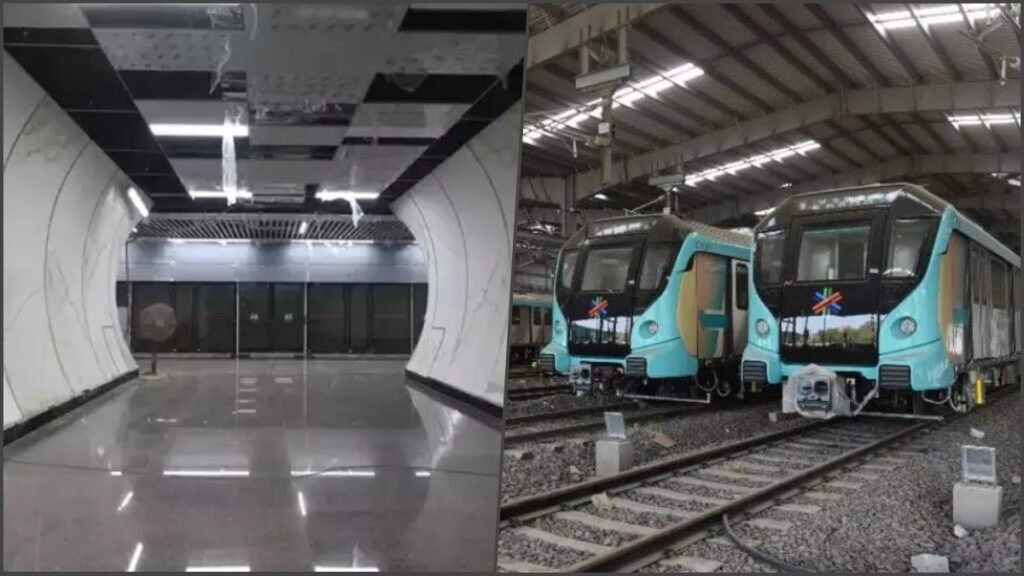
Mumbai: The long-awaited first phase of Mumbai’s underground metro is on the verge of transforming daily commutes, with operations expected to begin in the first week of October. Spanning 12.44 kilometers and encompassing 10 key stations, this new metro line promises to alleviate the city’s notorious traffic woes, particularly on the congested route from Aarey JVLR to Bandra Kurla Complex (BKC).
MMRC MD Ashwini Bhide confirmed that preparations are in full swing for the launch, with the rolling stock already approved and trials for the Commissioner of Metro Railway Safety (CMRS) scheduled to take place this week. While the exact inauguration date remains unconfirmed, excitement is building as the city gears up for this milestone in public transport.
260 Daily Round Trips to Serve Over 6 Lakh Commuters
The first phase of the underground metro will initially operate nine trains, completing 260 round trips daily. Officials estimate that this line will serve 6.5 lakh passengers on weekdays and 4.5 lakh on weekends, significantly reducing travel time and road congestion. Currently, 98.7% of the project’s work is complete, and upon launch, commuters will be able to travel from Aarey JVLR to BKC in just 23 minutes.
With an eye on affordability, the minimum fare has been set at Rs 10, while the maximum fare will be Rs 70. For the first phase, however, the highest ticket price will be capped at Rs 50, making it an economical choice for Mumbai’s working population.
Enhanced Connectivity with Telecom Services on the Go
Passengers on Metro Line 3 will not have to worry about losing mobile network coverage during their journey. The MMRC has partnered with Access India Private Limited, a subsidiary of Saudi Arabia-based Aces, to install telecom infrastructure along the route. This will enable passengers to access mobile and internet services, with Wi-Fi also being made available on the Aqua Line. Telecom companies have already begun setting up the required equipment, ensuring seamless connectivity throughout the underground ride.
Affordable Travel Through Innovative Revenue Models
To further reduce passenger fares, the MMRC has secured a 15-year contract with Microscan Infocomtech Private Limited to generate non-fare revenue. By utilizing the Optical Fiber Cable (OFC) installed in the underground tunnels along the 33.5 km stretch of Mumbai Metro Line 3, Microscan will lay additional OFC, thus generating extra revenue while minimizing costs for commuters. This strategic move will help keep ticket prices affordable in the long run, ensuring the metro remains a budget-friendly option for Mumbaikars.
A Unique Underground Infrastructure for a Crowded City
Speaking about the uniqueness of Mumbai’s underground metro, MMRC MD Ashwini Bhide highlighted the importance of building below ground in a city where space is a premium. “In Mumbai, where land is extremely scarce, constructing an underground metro allows the city to develop without disrupting above-ground activities,” she said. She also emphasized the significance of the project’s non-fare revenue strategy in keeping travel affordable, noting that balancing costs while delivering cutting-edge infrastructure is key to the metro’s success.
Phase 1: Key Stations to Transform Commutes
- Aarey JVLR
- SEEPZ
- MIDC Andheri
- Marol Naka
- Chhatrapati Shivaji Maharaj International Airport T2
- Sahar Road
- Chhatrapati Shivaji Maharaj International Airport T1
- Santacruz
- Vidyanagari
- BKC

With the opening of this high-tech underground metro, Mumbai is set to take a giant leap forward in urban transport, offering faster, more efficient, and affordable travel to millions of daily commuters.






















































